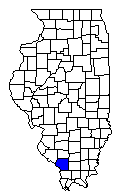
JAMES H. MARTIN. Among the essentially representative citizens of
Murphysboro, Jackson county, whose influence and activities have contributed
to the economic and social progress of this favored section of the state,
stands James H. Martin, who claims the fine old Hoosier commonwealth as the
place of his nativity, but the major part of whose life has been passed in
Illinois. He is one of the leading members of the bar of Jackson county, and
is a citizen of broad views and marked progressiveness. He is identified
with various important corporations in his home city, including the City
National Bank of Murphysboro, of which he is a director and concerning which
specific mention is made in other parts of this publication.
Mr.
Martin was born in Ripley county, Indiana, on the 18th day of October, 1852.
He was a child at the time of his parents' removal to Illinois, the family
settling in Richland county in 1865. There he was reared to adult age and
there he availed himself of the advantages of the public schools. That he
made good use of his opportunities is indicated by the fact that as a youth
he taught school for some time in the country districts, and proved himself
an able and popular exponent of the pedagogic profession. He early
formulated different plans for a future career, and decided to prepare
himself for the profession of law. With this end in view he began his
studies under a private preceptor and finally entered the law department of
the celebrated University of Michigan at Ann Arbor, where he remained until
1880. He was admitted to the bar in May of 1880, and shortly afterwards he
established his home in Murphysboro, Illinois, where he has continued in
effective practice during the long, intervening years. This interval has
been marked by worthy accomplishments on his part, and he has gained
prestige as one of the ablest and most conscientious representatives of his
profession in this section of the state. For a number of years past he has
given his attention principally to real-estate, common law and chancery
practice, and along these lines he controls a large and representative
business.
In all that pertains to the general welfare of the
community, Mr. Martin has shown a loyal and public-spirited interest. He has
gained a secure vantage ground in the confidence and esteem of the community
in which he has so long made his home. He is a strong advocate of the
principles and policies for which the Democratic party stands sponsor, and
while he has given praiseworthy service in behalf of the party, he has never
been an aspirant for political office. He was nominated at one time for the
office of judge of the circuit court, but he declined the nomination. Since
1908 he has served as president of the board of education of the Murphysboro
Township High School, and in the line of his profession he is attorney for
several of the representative corporations of his home city, including the
Jackson County Homestead Loan and Building Association, of which he was the
principal organizer. In 1892 he was appointed attorney for the City National
Bank, of which he has been a director from the time of its organization. He
is attorney for the Murphysboro Telephone Company, as well as the Ohio &
Mississippi Valley Telephone Company. In a fraternal way he is identified
with the local lodge of the Knights of Pythias.
In the year 1888, on
November 13, was solemnized the marriage of Mr. Martin to Miss Elizabeth
Kennedy, daughter of George and Ellen (Ross) Kennedy, for many years
residents of Murphysboro. Mr. Kennedy was engaged in the mercantile business
for fully forty years in that city, being well and favorably known in the
community where he has made his home for so many years. Mr. and Mrs. Martin
have two children: Milford M., who is a student at the Murphysboro township
high school, and Anna K., who was graduated from the Murphysboro high school
as a member of the class of 1909, and who is now Mrs. Otis F. Glenn.
Extracted 15 Jan 2018 by Norma Hass from 1912 A History of Southern Illinois, volume 2, pages 676-677.
Randolph |
Perry | Franklin |
Perry MO |
 |
Williamson |
| Union |


